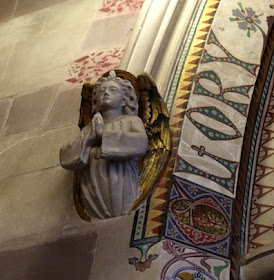Wednesday, August 17, 2016
Huntley, Gloucestershire
Gothic on speed
Set back from the main road from Gloucester to Ross, St John the Baptist, Huntley, is a church I’d been past many times before the Resident Wise Woman and I took the trouble to pull in and have a good look. And we were pleased we did. It’s one of the most interesting Victorian churches I’ve come across. Apart from the tower, which is 14th century, the whole church was rebuilt in 1862–3 by Samuel Sanders Teulon. There must have been a very generous budget (provided by the rector, Rev Daniel Capper) because this little building shows what Teulon could do when he threw everything he had at a church.
Huntley: the window of the organ chamber
The style is a kind of Decorated Gothic, the style of the 14th century that is marked by flowing window tracery, much carving, and a rich approach to decoration generally. But here at Huntley, Teulon gave it many special twists and turns. He elaborated everything: the Decorated window tracery flows more curvaceously than ever, the carving is more profuse, the painted chancel ceiling glows jewel-like. The elaboration starts before we even get inside, with an extraordinary trefoil-headed window (above) that looks like the top of a conventional Gothic window, but with the lower part replaced with a row of five little blind arches filled with decorative carving. The reason for the lack of glazing lower down is that the organ is installed behind – it’s signalled, indeed by carvings of a couple of musical figures that adorn the window. And this is just a hint of what awaits us inside.
Huntley: one capital or two?
Here architectural sculpture breaks loose from its bounds. Profuse isn’t a strong enough word for this interior and its decoration. At the tops of some of the columns are not simply capitals, but what almost amount to pairs of capitals (above), one over the other, the two levels of carving separated by a band of masonry studded with polished stones. The nave roof is supported by carved stone corbels – but there are more carvings immediately below them, framed by banded masonry and picked out with gilding. Teulon was able to employ one of the best Victorian carvers, Thomas Earp, whose work on the reredos and pulpit was shown at the Great Exhibition of 1862.
This is just a sample from this rich and absorbing little building, a Gothic revival structure that’s so elaborated it’s like no medieval church. The architect and critic Harry Goodhart-Rendell wrote an essay, ‘Rogue Architects of the Victorian Era’, in which he included Teulon in a group of pushers of the architectural envelope, men who broke rules triumphantly, who trumpeted their innovations with noisy visual glee, who had, presumably, the kind of pachydermous skins that made them oblivious to the criticism of more conventional souls. How good that they did, and that they found patrons like Capper who gave them the resources to work in the way they wanted.
Huntley: the angels have gilded wings and haloes




I must remember to visit here myself some time. "Rogue Gothic" at its very "roguest". Nearby Highnam (connections with Charles Hubert Hastings Parry, "Jerusalem", "Blest Pair of Sirens" - had to try and memorise and sing one of the parts in the latter when a teenager) I found impressive too, even just the exterior and grounds. What's left of Lassington (just a tower) is also nearby - reportedly Anglo-Saxon work, but the church itself had to be pulled down. Just as a lot of Rogue Gothic Victorian churches have been, or put to unworthy uses. In one in Cardiff you can buy plastic bowls just under a pulpit with angels. I didn't feel like lingering to view the architecture.
ReplyDeleteHighnam is terrific – the interior with its frescoes by Thomas Gambier Parry as much as the exterior.
ReplyDeleteI really enjoy what I learn from this Blog Philip. Always interesting, often surprising and amusing. So I have just voted for you!
ReplyDeleteCLICK HERE for Bazza’s fabulous Blog ‘To Discover Ice’
Thanks, Bazza. You're a gent.
ReplyDeleteThese buildings are gorgeous! I'm thinking of remodeling my home to look just like this but I think I might add in wood floors. Did they have that back then?
ReplyDeleteNicole: I'm pleased this is inspiring you! Houses from the Victorian period usually had wooden floors (I once had a Victorian house with plain pine wood floors), but Victorian churches like the one I've illustrated here usually had tiled floors. The tiles could be red, or pale stone coloured, or encaustic tiles with a mixture of colour clays to produce a pattern. If you look at the floor of All Saints' Margaret Street, London, you can see a mix of different Victorian floor tiles: https://en.wikipedia.org/wiki/All_Saints,_Margaret_Street#/media/File:All_Saints_Margaret_Street_Interior_1,_London,_UK_-_Diliff.jpg
ReplyDeleteOh, this is really lovely. I'm not so sure about the double capitals, but the foliate carving and everything else is absolutely delightful.
ReplyDeleteDitto regarding voting for you, Philip. I always find something to delight, interest and educate in your blogs. All the very best. :)
Thank you very, Eileen. I really appreciate your comments - and your vote!
ReplyDelete